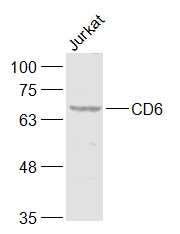
Rabbit Anti-CD6 antibody
CD_antigen=CD6; CD6; CD6 antigen Tp120; CD6_HUMAN; FLJ44171; OX52; T cell differentiation antigen CD6; T-cell differentiation antigen CD6; T12; TP120.
View History [Clear]
Details
Product Name CD6 Chinese Name CD6抗体 Alias CD_antigen=CD6; CD6; CD6 antigen Tp120; CD6_HUMAN; FLJ44171; OX52; T cell differentiation antigen CD6; T-cell differentiation antigen CD6; T12; TP120. Research Area Cell biology Stem cells lymphocyte t-lymphocyte Immunogen Species Rabbit Clonality Polyclonal React Species Human, Mouse, (predicted: Rat, ) Applications WB=1:500-2000 ELISA=1:5000-10000
not yet tested in other applications.
optimal dilutions/concentrations should be determined by the end user.Theoretical molecular weight 70kDa Cellular localization The cell membrane Secretory protein Form Liquid Concentration 1mg/ml immunogen KLH conjugated synthetic peptide derived from human CD6: 251-350/668 Lsotype IgG Purification affinity purified by Protein A Buffer Solution 0.01M TBS(pH7.4) with 1% BSA, 0.03% Proclin300 and 50% Glycerol. Storage Shipped at 4℃. Store at -20 °C for one year. Avoid repeated freeze/thaw cycles. Attention This product as supplied is intended for research use only, not for use in human, therapeutic or diagnostic applications. PubMed PubMed Product Detail CD6 is a type I membrane protein expressed by thymocytes, mature T cells, a subset of B cells known as B1 cells, and some cells in the brain. CD6 is a member of the scavenger receptor cysteine rich (SRCR) family of proteins, which includes the leukocyte antigen CD5. The extracellular domain of CD6 is composed of three SRCR domains and has the same domain organization as CD5. The ligand for CD6 is CD166 also known as activated leukocyte cell adhesion molecule. Through its interaction with CD166 in the thymus, CD6 may have a role in T cell development.
Function:
Involved in cell adhesion. Binds to CD166.
Subcellular Location:
Membrane; Single-pass type I membrane protein.
Tissue Specificity:
Expressed by thymocytes, mature T-cells, a subset of B-cells known as B-1 cells, and by some cells in the brain.
Post-translational modifications:
After T-cell activation, becomes hyperphosphorylated on Ser and Thr residues and phosphorylated on Tyr residues.
Contains intrachain disulfide bond(s).
Similarity:
Contains 3 SRCR domains.
SWISS:
P30203
Gene ID:
923
Database links:Entrez Gene: 923 Human
Omim: 186720 Human
SwissProt: P30203 Human
Unigene: 57361 Rat
CD6是I型整合膜glycoprotein,属于SRCRSF( scavenger receptor cysteine-rich superfamily)成员。CD6在外周血T细胞和髓质的胸腺细胞表面表达,也表达在皮质的胸腺细胞、B1细胞、某些NK细胞、脑细胞、T细胞或B细胞的慢性白血病细胞上。 CD6参与T细胞活化,调节T细胞功能和介导细胞-细胞间的粘附。CD6分子可与TCR/CD3形成复合体,参与免疫突触(immunological synapse,IS)的形成。
在自身性免疫性疾病发病机制中,T细胞增殖活化和迁移过程起着重要作用。基于CD6分子在lymphocyte成熟、活化和增殖中的重要作用,阻断CD6分子的功能可为类风湿性关节炎、银屑病等自身免疫的治疗提供新的治疗手段和方法.Product Picture
References (0)
No References
Bought notes(bought amounts latest0)
No one bought this product
User Comment(Total0User Comment Num)
- No comment



 +86 571 56623320
+86 571 56623320
 +86 18668110335
+86 18668110335

